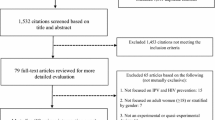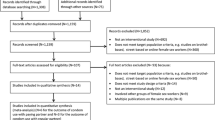Abstract
This paper describes a 10-session behavioral intervention introducing female-initiated methods of human immunodeficiency virus (HIV) prevention to reduce vulnerability to HIV infection for women with severe mental illness. In a pilot test of the intervention, 35 women were randomly placed in the experimental intervention group or an HIV education control. Subjective norms, intentions to use, perceived efficacy, and attitudes toward the male condom, female condom, and a microbicide were assessed at baseline, postintervention, and 6-week follow-up. The participants in the treatment group reported a significantly more positive attitude toward the use of female condoms (t = −2.12, P <.05) at 6-week follow-up. Providing women with severe mental illness with choices o f protective methods and the knowledge and skills to ensure proper use are among the many crucial ingredients in prevention of acquired immunodeficiency syndrome.
Similar content being viewed by others
References
Susser E, Colson P, Jandorf L, et al. HIV infection among young adults with psychotic disorders. Am J Psychiatry. 1997;154:864–866.
Cournos F, Herman R, Kaplan M, McKinnon K. AIDS prevention for people with severe mental illness. J Pract Psychiatry Behav Health. 1997;3:285–292.
Volavka J, Concit A, Czobor P, Douyon R, O’Donnell J, Ventura F. HIV seroprevalence and risk behaviors in psychiatric in-patients. Psychiatr Res. 1991;39:109–114.
Cournos F, Empfield M, Horwath E, et al. HIV seroprevalence among patients admitted to two psychiatric hospitals. Am J Psychiatry. 1991;148:1225–1230.
Cournos F, Guido JR, Coomaraswamy S, Meyer-Bahlburg H, Sugden R, Horwath E. Sexual activity and risk of HIV infection among patients with schizophrenia. Am J Psychiatry. 1994;151:228–232.
Kalichman SC, Kelly JA, Johnson JR, Bulto M. Factors associated with risk for HIV infection among chronically mentally ill adults. Am J Psychiatry. 1994;151:221–227.
Kelly JA, Murphy DA, Bahr GR, et al. AIDS/HIV risk behavior among the chronic mentally ill. Am J Psychiatry. 1992;149;886–889.
Susser E, Valencia E, Miller M, Meyer Bahlburg H, Tsai W, Conover S. Sexual behaviors of homeless mentally ill men at risk for HIV. Am J Psychiatry. 1995;152:583–587.
Cournos F, Bakalar N, eds. AIDS and People with Severe Mental Illness. New Haven, CT: Yale University Press; 1996.
Carey MP, Weinhardt LS, Carey KB. Prevalence of infection with HIV among the seriously mentally ill: review of research and implications for practice. Prof Psychol Res Pract. 1995;26:262–268.
Cohen CI. Poverty and the course of schizophrenia: implications for research and policy. Hosp Community Psychiatry. 1993;44(10):951–958.
Weinhardt LS, Carey MP, Carey KB. HIV-risk behavior and the public health context of HIV/AIDS among women living with a severe and persistent mental illness. J Nerv Ment Dis. 1998;186:276–282.
Goodman LA, Rosenberg SD, Mueser KT, Drake RE. Physical and sexual assault history in women with sevence, correlates, treatment and future research directions. Schizophr Bull. 1997;23:685–696.
Miller LJ, Finnerty M. Sexuality, pregnancy, and child rearing among women with schizophrenia-spectrum disorders. Psychiatr Serv. 1996;47:502–506.
Gearon JS, Bellack AS. Women with schizophrenia and co-occurring substance use disorders: an increased risk for violent victimization and HIV. Community Ment Health J. 1999;35:401–419.
Heise LL. Freedom close to home: the impact of violence against women on reproductive rights. In: Peters J, Wolper A, eds. Women’s Rights Human Rights. New York: Routledge; 1995:238–255.
McKinnon K, Cournos F, Sugden R, Guido JR. The relative contribution of psychiatric symptoms and AID knowledge to HIV risk behaviors among people with severe mental illness. J Clin Psychiatry. 1996;57:506–513.
Stiffman AR, Dore P, Earls F, Cunningham R. The influence of mental health problems on AIDS-related risk behaviors in young adults. J Nerv Ment Dis. 1992;180:314–320.
Green MF. What are the functional consequences of neurocognitive deficits in schizophrenia? Am J Psychiatry. 1996;153: 321–330.
Wallace CJ. Social skills training in psychiatric rehabilitation: recent findings. Int Rev Psychiatry. 1998;10:9–19
Weinhardt LS, Carey MP, Carey KB, Verdecias RN. Increasing assertiveness skills to reduce HIV risk among women living with severe and persistent mental illness. J Consult Clin Psychol. 1998;66:680–684.
Susser E. Working with people who are mentally ill and homeless: the role of a psychiatrist. In: Jahiel RI, ed. Homelessness: a Prevention-Oriented Approach. Baltimore, MD: The Johns Hopkins University Press; 1992: 207–217.
Waterston A. Anthropological research and the politics of HIV prevention: toward a critique of policy and priorities in the age of AIDS. Soc Sci Med. 1997;44:1381–1391.
Collins PY, Sohler N, Susser E. The potential of female-controlled methods of HIV prevention among women with mental illness. Health Psycbol. 1997;18:9,20–21.
Rosenberg MJ, Gollub EL. Commentary: methods women can use that may prevent sexually transmitted disease, including HIV. Am J Public Health. 1992;82:1473–1477.
New York State AIDS Institute. AIDS in New York State. Albany, NY: New York State Department of Health; 1996.
US Food and Drug Administration. Vaginal contraceptive drug products for over-the-counter human use. 45 Federal Register 82014-82049 (1980).
Weir SS, Feldblum PJ, Zekeng L, Roddy RE. The use of nonoxynol-9 for protection against cervical gonorrhea. Am J Public Health. 1994;84:910–914.
Hicks DR, Martin LA, Getchell JP, et al. Inactivation of HTLV-II/LAV-infected lymphocytes by nonoxynol-9 in vitro. Lancet. 1985;2:1422–1423.
Feldblum P, Hira S, Goodwin S, Kamanga J, Mukelabale G. Efficacy of spermicide use and condom use by HIV-discordant couples in Zambia. In: Program and abstracts of VIII International Conference on AIDS/III STD World Congress; July 19–24, 1992; Amsterdam. Abstract WeC1085.
Kreiss J, Ngugi E, Holme K, et al. Efficacy of nonoxynol-9 contraceptive sponge use in preventing heterosexual acquisition of HIV in Nairobi prostitutes. JAMA. 1992;268:477–482.
Wittkowski KM, Susser E, Dietz K. The protective effect of condoms and nonoxynol-9 against HIV infection. Am J Public Health. 1998;88:590–596.
Van Damme L, Niruthisard S, Atisook R, et al. Safety evaluation of nonoxynol-9 gel in women at low risk of HIV infection. AIDS. 1998;12:433–437.
Van Damme L. Advances in topical microbicides. Paper presented at: 13th International AIDS Conference; July 9–14, 2000; Durban, South Africa.
Elias CJ, Coggins C. Female-controlled methods to prevent sexual transmission of HIV. AIDS. 1996;10(suppl 3):S43-S51.
Stein Z, Saez H, EI-Sadr W, et al. Safer sex strategies for women: the hierarchical model in methadone treatment clinics. J Urban Health. 1999;76:62–72.
Farr GA, Acosta Castro LA, Disantostefano R, Claasen E, Olguin F. Use of spermicide condom use among sex workers in Santa Fe de Bogota, Colombia. Sex Transm Dis. 1996;23:206–212.
Latka M, Gollub E, French P, Stein Z. Male and female condom use among women after counseling in a risk reduction hierarchy for STD prevention. Sex Transm Dis. 2000;27:431–437.
Bandura A. Perceived self-efficacy in the exercise of control over AIDS infection. In: Mays VM, Albee GW, Schneider SF, eds. Primary Prevention of AIDS: Psychological Approaches. Newbury Park, CA: Sage; 1988:128–141.
Exner TM, Seal DW, Ehrhardt AA. A review of HIV interventions for at-risk women. AIDS Bebav. 1997;1:93–124.
Meyer-Bahlburg H, Ehrhardt A, Exner TM, Gruen RS. Sexual Risk Behavior Assessment Schedule-Adult Armory Interview (SERBAS-A-ARMM-1). New York, NY: Program of Developmental Psychoendocrinology, New York State Psychiatric Institute and Department of Psychiatry, College of Physicians and Surgeons of Columbia University; 1991.
Fontanet AL, Sabha J, Chandeying V, et al. Protection against sexually transmitted diseases by granting sex workers in Thailand the choice of using the male of female condom: results from a randomized controlled trial. AIDS. 1998;12:1851–1859.
Menon AS, Pomerantz S, Harowitz S, et al. The high prevalence of unsafe sexual behaviors among acute psychiatric inpatients. J Nerv Ment Dis. 1994;182:661–666.
Amaro H. Love, sex, and power: considering women’s realities in HIV prevention. Am Psycbol. 1995;50:437–447.
Zierler S, Krieger N. Reframing women’s risk: social inequalities and HIV infection. Annu Rev Public Health. 1997; 18;401–436.
Miller JB. Toward a New Psychology of Women. Boston, MA: Beacon Press; 1986.
Stokols D. Translating social ecological theory into guidelines for community health promotion. Am J Health Promot. 1996;10:282–298.
Author information
Authors and Affiliations
Corresponding author
Additional information
This study was conducted with support from the National Institute of Mental Health (training grant 5-T32-MH19126, R01 MH58917, and K01MH01691), the Robert Wood Johnson Foundation (033352), and a New York State Psychiatric Institute research study grant.
Rights and permissions
About this article
Cite this article
Collins, P.Y., Geller, P.A., Miller, S. et al. Ourselves, our bodies, our realities: An HIV prevention intervention for women with severe mental illness. J Urban Health 78, 162–175 (2001). https://doi.org/10.1093/jurban/78.1.162
Issue Date:
DOI: https://doi.org/10.1093/jurban/78.1.162




